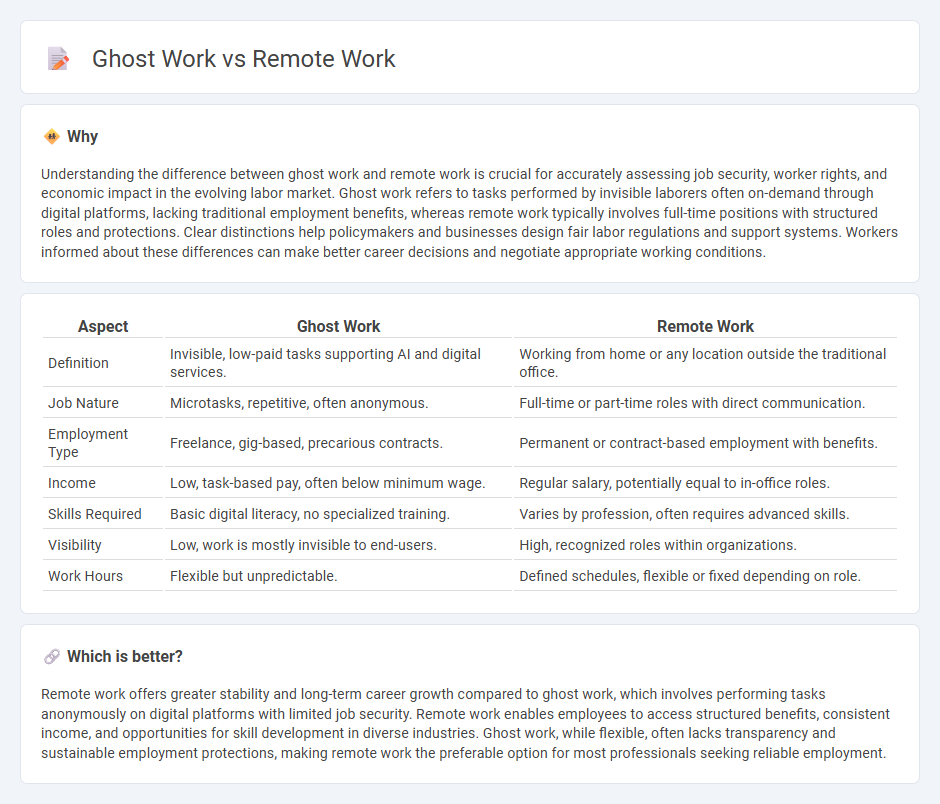
Ghost work involves tasks completed by invisible workers often through digital platforms without traditional employment benefits, while remote work allows employees to perform their job duties from outside a central office, maintaining formal employment status and associated protections. This shift in employment models highlights evolving labor dynamics driven by technology and changing organizational structures. Explore the differences and implications of ghost work versus remote work in today's job market.
Why it is important
Understanding the difference between ghost work and remote work is crucial for accurately assessing job security, worker rights, and economic impact in the evolving labor market. Ghost work refers to tasks performed by invisible laborers often on-demand through digital platforms, lacking traditional employment benefits, whereas remote work typically involves full-time positions with structured roles and protections. Clear distinctions help policymakers and businesses design fair labor regulations and support systems. Workers informed about these differences can make better career decisions and negotiate appropriate working conditions.
Comparison Table
| Aspect | Ghost Work | Remote Work |
|---|---|---|
| Definition | Invisible, low-paid tasks supporting AI and digital services. | Working from home or any location outside the traditional office. |
| Job Nature | Microtasks, repetitive, often anonymous. | Full-time or part-time roles with direct communication. |
| Employment Type | Freelance, gig-based, precarious contracts. | Permanent or contract-based employment with benefits. |
| Income | Low, task-based pay, often below minimum wage. | Regular salary, potentially equal to in-office roles. |
| Skills Required | Basic digital literacy, no specialized training. | Varies by profession, often requires advanced skills. |
| Visibility | Low, work is mostly invisible to end-users. | High, recognized roles within organizations. |
| Work Hours | Flexible but unpredictable. | Defined schedules, flexible or fixed depending on role. |
Which is better?
Remote work offers greater stability and long-term career growth compared to ghost work, which involves performing tasks anonymously on digital platforms with limited job security. Remote work enables employees to access structured benefits, consistent income, and opportunities for skill development in diverse industries. Ghost work, while flexible, often lacks transparency and sustainable employment protections, making remote work the preferable option for most professionals seeking reliable employment.
Connection
Ghost work and remote work intersect through the reliance on digital platforms enabling distributed labor for tasks like content moderation, data labeling, and customer support. This connection highlights the rise of invisible labor performed remotely, often characterized by low pay and limited recognition despite being essential to AI and online services. Understanding this link reveals challenges in workers' rights and the need for improved transparency and fair compensation in platform-based employment models.
Key Terms
Telecommuting
Telecommuting, a prominent form of remote work, enables employees to perform tasks outside traditional office settings using digital communication tools, fostering flexibility and productivity. In contrast, ghost work involves online tasks often executed anonymously via platforms, typically lacking direct employment relationships or consistent interaction. Explore the key differences and implications of telecommuting versus ghost work to understand their roles in the evolving labor landscape.
Gig Economy
Remote work in the gig economy enables workers to perform tasks online from any location, offering flexibility and access to diverse projects. Ghost work refers to invisible labor behind the scenes, such as content moderation and data labeling, often unrecognized despite powering AI and digital platforms. Explore how these distinct roles shape the future of work in the gig economy.
Digital Labor
Digital labor encompasses both remote work and ghost work, highlighting distinct forms of online employment. Remote work involves professionals performing tasks from various locations, leveraging technology for communication and productivity, while ghost work refers to invisible human labor behind AI systems, such as data labeling and content moderation. Explore the evolving dynamics of digital labor to understand its impact on the future workforce.
Source and External Links
What Is Remote Work? Ultimate Guide | Wrike - Remote work is a professional environment where employees work outside their company's physical office, commonly from home or any location, facilitated by digital tools like Slack and Zoom, enabling a growing trend toward flexible and hybrid work models.
Remote work - Wikipedia - Remote work, also known as telecommuting or telework, involves working from home or other locations instead of an office and has increased significantly with technology advances and the COVID-19 pandemic, offering benefits like reduced costs and flexible schedules but also challenges such as isolation and distractions.
What is the definition of remote work? - OPM.gov - Remote work is defined as a flexible work arrangement with a written agreement where an employee works at an alternative site regularly instead of the usual agency worksite, which may be inside or outside the local commuting area.
 dowidth.com
dowidth.com